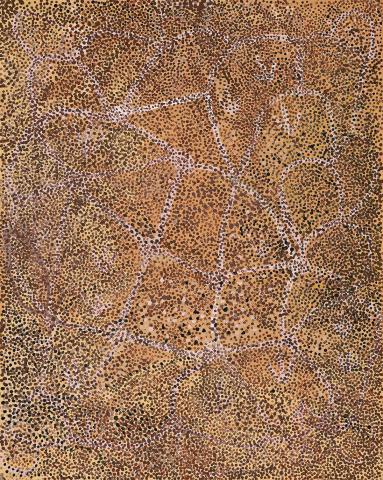ALHALKERE (MY COUNTRY), 1990
EMILY KAME KNGWARREYE
synthetic polymer paint on linen
150.0 x 120.0 cm
bears inscription verso: artist’s name and Delmore Gallery cat. OG25
Delmore Gallery, Alice Springs
Gabrielle Pizzi Gallery, Melbourne (label attached verso)
Private collection, Melbourne
Paintings by Emily Kame Kngwarreye, Gallery Gabrielle Pizzi, Melbourne, 1990
Emu Story, E002, 1989, synthetic polymer paint on canvas, 151.0 x 120.0 cm, formerly in the Delmore Gallery collection, Northern Territory, illus. in Isaacs, J., Smith, T., Ryan, J., Holt, D., and Holt,J., Emily Kame Kngwarreye Paintings, Craftsman House, Sydney, 1998, p. 47, pl. 4
This work is accompanied by a certificate of authenticity from Delmore Gallery, Alice Springs
‘Alhalkere’, Emily Kngwarreye answered when questioned by Rodney Gooch about her imagery is, ‘Whole lot, that’s whole lot, Awelye (my Dreaming), Arlatyeye (pencil yam), Arkerrthe (mountain devil lizard), Ntange (grass seed), Tingu (Dreamtime pup), Ankerre (emu), Intekwe (favourite food of emus, a small plant), Atnwerle (green bean), and Kame (yam seed). That’s what I paint, whole lot’.1 Not only the place of her birth, Alhalkere was ultimately the nexus of everything that empowered Kngwarreye’s life, reflecting her participation in ceremony and a lifetime of traditional cultural practice, this small triangular shaped land was the place and the law that she continually re-created in her art
Kngwarreye holds a position in history as one of Australia’s most significant contemporary artists and it is difficult to think of another artist who, having started painting so late in life, left such an enduring mark on modern Australian art. She was a prolific artist who often worked at a pace that belied her advanced age. It is estimated that she produced over 3000 paintings in the course of her eight-year painting career — an average of one painting per day. For virtually two-thirds of her life she had only sporadic contact with the outside world. It was not until she was about 80 that she became, almost overnight, an artist of national and international standing.
Painted in the late summer heat of February 1990, Alhalkere (My Country) was included in the artist’s first solo exhibition in Melbourne, held that same year at Gallery Gabrielle Pizzi. Characteristic of her early tonal paintings and refreshingly free flowing, this work is painted over a golden ground with irregular shapes created by a meandering pink and white line that maps the underground spread of the roots of the Arlatyeye (pencil yam), contained only by the rectangular shape of the canvas. These shapes are infilled with sequences of distinct dots of differing colours that are aligned between and straddled over the lines creating a mesmerising carpet built up through rhythmic application, suggesting the overlaying of leaves and flowers above the subterranean root system. Emu tracks bisect the painting and the random scattering of black dots suggests seeds and the black desert plum, a favourite food of the emu.
Her remarkable work, inspired by her cultural life as an Anmatyerre elder, and her lifelong custodianship of the women’s Dreaming sites in her clan Country radically altered the way in which we see and understand modern Aboriginal art. While much has been made of the way in which we might view her work in parallel with modern, non-indigenous abstraction, we must first recognise her achievement as a truly inventive and original contribution to Aboriginal art.
1. Kngwarreye, E., interviewed by Rodney Gooch, Soakage Bore, 1990, translated by Kathleen Petyarre, in Boulter, M., The Art of Utopia, A New Direction in Contemporary Aboriginal Art, Craftsman House, Sydney, 1991, p. 61
CRISPIN GUTTERIDGE
